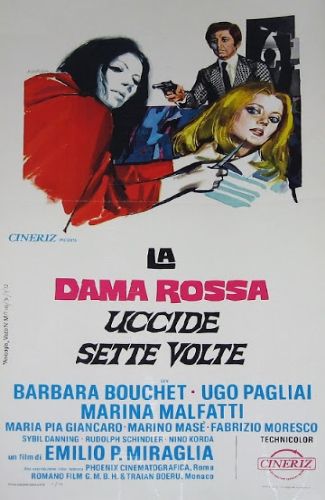
One would be justified in saying that director Emilio Miraglia's genre output is hardly prolific, consisting of merely two films, 1971's La notte che Evelyn usci dalla tomba aka/ The Night Evelyn Came Out of the Grave, and the film he made the following year, which just so happens to be the one we'll be focusing on tonight, but most of his fans would also agree that the caliber of his work far negates the scarcity of it. Nowhere is that more apparent than here, a stylishly framed giallo of the highest order, with plenty of atmosphere and complexity, vibrant colors, beautiful women, and violent death set against the gothic backdrop of a castle with a murderous history that even the most gluttonous genre-gastronomes will find themselves well gorged on by the final reel.

"Teste rotoleranno se non ottenete dalla mia vista!"
After watching adorable little blonde Kitty's unbalanced brunette sister Evelyn gleefully stab up and remove the head-piece of her favorite doll in front of an odd painting of two historical sisters at perpetual war with each other in hundred year intervals, their kindly old grandpa decides that it'd be a good time to lay the castle's well-worn legend of the Black Queen and Red Queen on them, having barely just stopped a crazed Evelyn (who's also been singsong-edly repeating "I am the Red Lady, and Kitty is the Black Lady!", mind you) from turning the ornately decorated blade on her own hysterical sister. That oughta calm them down, for sure. You see, the Black Queen killed the Red one, titularly stabbing her seven times, before she vengefully arose from her grave a year later, killing seven people herself, with her seventh and final victim being her sibling-in-black. You know, I'm no psychic or anything, but I'd lay a c-note on the possibility that something very similar to the legend is going to occur between these two tiny terrors when they grow up...
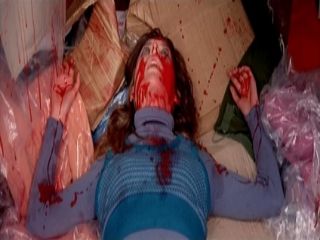
Damn, you leakin'....brang ambalamps.
Wouldn't you know it, years later, a beautiful adult version of Kitty (Barbara Bouchet), now a highly touted fashion photographer, stands to gain a large inheritance in twelve months time, except that a pale figure with dark hair in a red cape that many have identified as the Red Queen with the maniacal laugh herself, has begun stalking and offing folks in a savage (yet strangely inventive) manner nearby. Kitty's pretty sure it can't be Evelyn, since she ran off to the States...or she may have been accidentally snuffed during an icy catfight, and possibly by her golden-haired sister, at that. Then, we've got her ambitious beau, Martin (Ugo Pagliai), who's in line for promotion in fashion house management when he's not fighting off the amorous advances of Lulu Palm (Sybil Danning), a model who's even more enterprising than he is, and often quite vocal about her sexual prowess, when she isn't shedding every stitch of gear in a Manhattan millisecond, just to prove her point, Gods bless her. Herrings-a-plenty, and each as red as the titular Queen's memorable hooded cape, follow, and of course, I'm not going to spoil any of the gruesome goings on here for you. See it.

This particular blonde queen(Sybil Danning) kills me innumerable times.
The picturesque blonde Bouchet would appear throughout the decade in genre fare such as La tarantola dal ventre nero aka/ Black Belly of the Tarantula (1971) and Fernando Di Leo's Milano calibro 9 aka/ Caliber 9 (1972) , Casa d'appuntamento aka/ The French Sex Murders (1972), as well as Fulci's No si sevizia un paperino aka/ Don't Torture a Duckling (1972). She'd later represent the "Have's" (versus the "Have Not's", of course) in Scorsese's Gangs of New York (2002), which also features a brief cameo from Johnny Morghen, interestingly enough. Meanwhile, besides her roles in both of Miraglia's genre efforts, Marina Malfatti was showing up in things like Eugenio Martin's La ultima senora Anderson aka/ Death at the Deep End of the Swimming Pool (1971), Sette orchidee macchiate di rosso aka/ Seven Bloodstained Orchids (1972), Sergio Martino's Tutti i colori del buio aka/ All the Colors of the Dark (1972), and Il prato macchiato di rosso (1973).While we're on the subject, I should probably mention that Sybil Danning...sigh...would also appear in L'occhio nel labirinto (1972). You could still pick up the famed Miraglia Killer Queen box set from NoShame (which not only includes both films, but a nifty sculpted figure of the Red Queen herself, and was limited to seven thousand copies) on Amazon for fifty bucks, so why wouldn't you. Not on par with Argento at his best, by any stretch of the imagination, but still... Four wops.
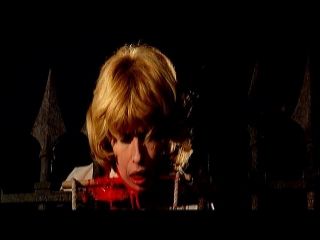
Lei ha molto sulla sua mente...come spuntoni recinzione.








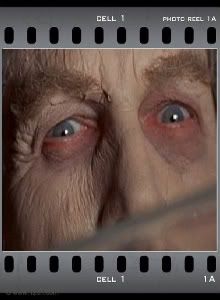
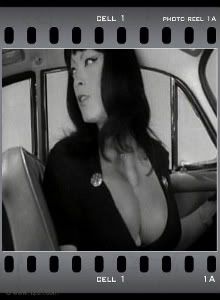
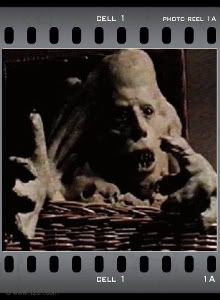





























No comments:
Post a Comment